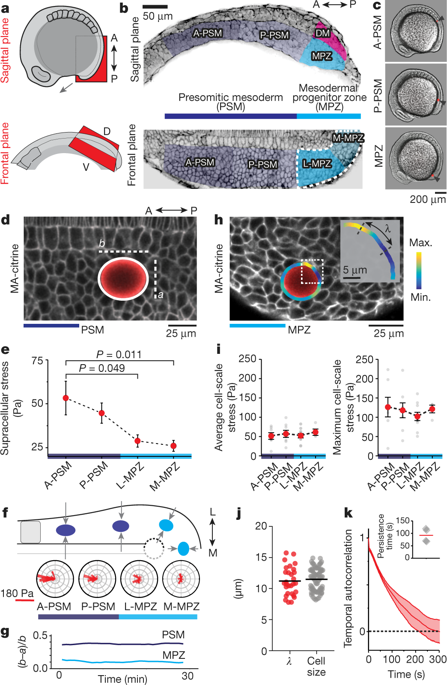Our official English website, www.x-mol.net, welcomes your
feedback! (Note: you will need to create a separate account there.)
A fluid-to-solid jamming transition underlies vertebrate body axis elongation
Nature ( IF 50.5 ) Pub Date : 2018-09-01 , DOI: 10.1038/s41586-018-0479-2 Alessandro Mongera , Payam Rowghanian , Hannah J. Gustafson , Elijah Shelton , David A. Kealhofer , Emmet K. Carn , Friedhelm Serwane , Adam A. Lucio , James Giammona , Otger Campàs
Nature ( IF 50.5 ) Pub Date : 2018-09-01 , DOI: 10.1038/s41586-018-0479-2 Alessandro Mongera , Payam Rowghanian , Hannah J. Gustafson , Elijah Shelton , David A. Kealhofer , Emmet K. Carn , Friedhelm Serwane , Adam A. Lucio , James Giammona , Otger Campàs

|
Just as in clay moulding or glass blowing, physically sculpting biological structures requires the constituent material to locally flow like a fluid while maintaining overall mechanical integrity like a solid. Disordered soft materials, such as foams, emulsions and colloidal suspensions, switch from fluid-like to solid-like behaviours at a jamming transition1–4. Similarly, cell collectives have been shown to display glassy dynamics in 2D and 3D5,6 and jamming in cultured epithelial monolayers7,8, behaviours recently predicted theoretically9–11 and proposed to influence asthma pathobiology8 and tumour progression12. However, little is known about whether these seemingly universal behaviours occur in vivo13 and, specifically, whether they play any functional part during embryonic morphogenesis. Here, by combining direct in vivo measurements of tissue mechanics with analysis of cellular dynamics, we show that during vertebrate body axis elongation, posterior tissues undergo a jamming transition from a fluid-like behaviour at the extending end, the mesodermal progenitor zone, to a solid-like behaviour in the presomitic mesoderm. We uncover an anteroposterior, N-cadherin-dependent gradient in yield stress that provides increasing mechanical integrity to the presomitic mesoderm, consistent with the tissue transiting from a wetter to a dryer foam-like architecture. Our results show that cell-scale stresses fluctuate rapidly (within about 1 min), enabling cell rearrangements and effectively ‘melting’ the tissue at the growing end. Persistent (more than 0.5 h) stresses at supracellular scales, rather than cell-scale stresses, guide morphogenetic flows in fluid-like tissue regions. Unidirectional axis extension is sustained by the reported rigidification of the presomitic mesoderm, which mechanically supports posterior, fluid-like tissues during remodelling before their maturation. The spatiotemporal control of fluid-like and solid-like tissue states may represent a generic physical mechanism of embryonic morphogenesis.Cell collectives in embryonic tissues undergo a fluid-to-solid jamming transition, similar to those that occur in soft materials such as foams, emulsions and colloidal suspensions, to physically sculpt the vertebrate body axis.
中文翻译:

流体到固体的干扰转变是脊椎动物体轴伸长的基础
就像粘土成型或玻璃吹制一样,物理雕刻生物结构需要组成材料像流体一样局部流动,同时像固体一样保持整体机械完整性。无序的软材料,如泡沫、乳液和胶体悬浮液,在干扰转变时从类流体行为转变为类固体行为 1-4。类似地,细胞群已被证明在 2D 和 3D5、6 中表现出玻璃状动力学,并在培养的单层上皮 7、8 中出现干扰,最近理论预测的行为 9-11 并提议影响哮喘病理学 8 和肿瘤进展 12。然而,关于这些看似普遍的行为是否发生在体内 13 ,特别是它们是否在胚胎形态发生过程中发挥任何功能作用,我们知之甚少。这里,通过将组织力学的直接体内测量与细胞动力学分析相结合,我们表明在脊椎动物体轴伸长期间,后部组织经历了从延伸端(中胚层祖细胞区)的流体状行为到固体的阻塞转变。像前体中胚层的行为。我们发现了屈服应力的前后、N-钙粘蛋白依赖性梯度,它为前体中胚层提供了增加的机械完整性,这与组织从较湿的泡沫状结构转变为较干的泡沫状结构一致。我们的结果表明,细胞规模的压力波动迅速(约 1 分钟内),使细胞重排并有效地“融化”生长末端的组织。超细胞尺度的持续(超过 0.5 小时)压力,而不是细胞尺度的压力,引导流体样组织区域的形态发生流动。据报道,前体中胚层的刚性化可以维持单向轴延伸,在成熟之前的重塑过程中,中胚层机械地支撑着后部的流体状组织。类流体和类固体组织状态的时空控制可能代表了胚胎形态发生的一般物理机制。胚胎组织中的细胞群经历了流体到固体的干扰转变,类似于在软材料(如泡沫、乳液和胶体悬浮液,以物理方式雕刻脊椎动物的身体轴。在成熟之前重塑过程中的流体样组织。类流体和类固体组织状态的时空控制可能代表了胚胎形态发生的一般物理机制。胚胎组织中的细胞群经历了流体到固体的干扰转变,类似于在软材料(如泡沫、乳液和胶体悬浮液,以物理方式雕刻脊椎动物的身体轴。在成熟之前重塑过程中的流体样组织。类流体和类固体组织状态的时空控制可能代表了胚胎形态发生的一般物理机制。胚胎组织中的细胞群经历了流体到固体的干扰转变,类似于在软材料(如泡沫、乳液和胶体悬浮液,以物理方式雕刻脊椎动物的身体轴。
更新日期:2018-09-01
中文翻译:

流体到固体的干扰转变是脊椎动物体轴伸长的基础
就像粘土成型或玻璃吹制一样,物理雕刻生物结构需要组成材料像流体一样局部流动,同时像固体一样保持整体机械完整性。无序的软材料,如泡沫、乳液和胶体悬浮液,在干扰转变时从类流体行为转变为类固体行为 1-4。类似地,细胞群已被证明在 2D 和 3D5、6 中表现出玻璃状动力学,并在培养的单层上皮 7、8 中出现干扰,最近理论预测的行为 9-11 并提议影响哮喘病理学 8 和肿瘤进展 12。然而,关于这些看似普遍的行为是否发生在体内 13 ,特别是它们是否在胚胎形态发生过程中发挥任何功能作用,我们知之甚少。这里,通过将组织力学的直接体内测量与细胞动力学分析相结合,我们表明在脊椎动物体轴伸长期间,后部组织经历了从延伸端(中胚层祖细胞区)的流体状行为到固体的阻塞转变。像前体中胚层的行为。我们发现了屈服应力的前后、N-钙粘蛋白依赖性梯度,它为前体中胚层提供了增加的机械完整性,这与组织从较湿的泡沫状结构转变为较干的泡沫状结构一致。我们的结果表明,细胞规模的压力波动迅速(约 1 分钟内),使细胞重排并有效地“融化”生长末端的组织。超细胞尺度的持续(超过 0.5 小时)压力,而不是细胞尺度的压力,引导流体样组织区域的形态发生流动。据报道,前体中胚层的刚性化可以维持单向轴延伸,在成熟之前的重塑过程中,中胚层机械地支撑着后部的流体状组织。类流体和类固体组织状态的时空控制可能代表了胚胎形态发生的一般物理机制。胚胎组织中的细胞群经历了流体到固体的干扰转变,类似于在软材料(如泡沫、乳液和胶体悬浮液,以物理方式雕刻脊椎动物的身体轴。在成熟之前重塑过程中的流体样组织。类流体和类固体组织状态的时空控制可能代表了胚胎形态发生的一般物理机制。胚胎组织中的细胞群经历了流体到固体的干扰转变,类似于在软材料(如泡沫、乳液和胶体悬浮液,以物理方式雕刻脊椎动物的身体轴。在成熟之前重塑过程中的流体样组织。类流体和类固体组织状态的时空控制可能代表了胚胎形态发生的一般物理机制。胚胎组织中的细胞群经历了流体到固体的干扰转变,类似于在软材料(如泡沫、乳液和胶体悬浮液,以物理方式雕刻脊椎动物的身体轴。











































 京公网安备 11010802027423号
京公网安备 11010802027423号